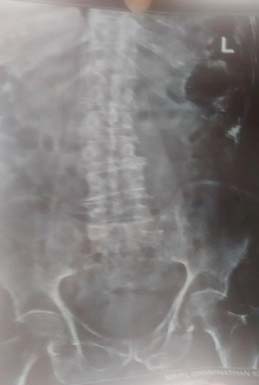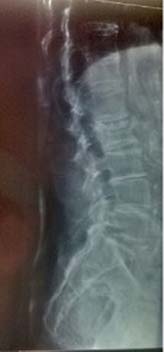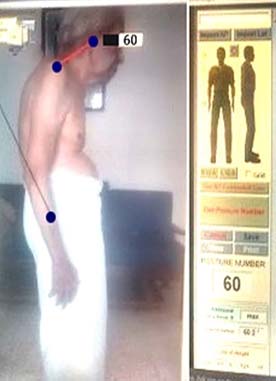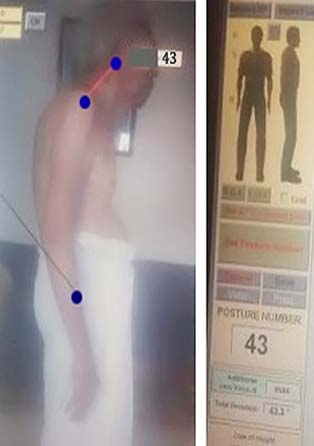Effect of Thoracic Correction Exercises in Upper Body Dysfunction of 94-Year-old Male Participant – A Case Report
P. Senthil1, S. Sudhakar2, R. Radhakrishnan3
1 Professor, Department of Physiotherapy, Mohamed Sathak A J College of Physiotherapy, Chennai, Tamilnadu, India.
2 Assistant Professor, Department of Arthroscopy and Sports Medicine, Sri Ramachandra University, Chennai, Tamilnadu, India.
3 Professor, Department of Physiotherapy, Mohamed Sathak A J College of Physiotherapy, Chennai, Tamilnadu, India.
NAME, ADDRESS, E-MAIL ID OF THE CORRESPONDING AUTHOR: Dr. P. Senthil, 5/738, G2, JR Nilayam, Vignarajapuram 3rd Extension, Santhosapuram, Chennai – 600073, Tamilnadu, India.
E-mail: senthilp101010@gmail.com
The case report has been presented to show the effects of thoracic correction exercises on flexed posture in older men with upper body dysfunction using posture analysis software and pectoralis minor muscle length test. The present case is that of a 94-year-old male. He was guided for a specific thoracic correction exercises for 12 weeks. The program included breathing correction, thorax mobility, scapular stability and passive stretching of Pectoralis major and minor, performed thrice a week, 30 min each session, for 12 weeks. Outcome measures included the upper body dysfunction changes by posture analysis software and pectoralis minor muscle length test. The Pre and Post–test of the patient demonstrated significantly greater improvements in hyperkyphosis (forward head posture) and pectoralis minor muscle length. This case study provides a promising exercise intervention that may improve flexed posture in older men with age-related upper body dysfunction.
Hyperkyphosis,Posture analysis,Thorax mobility
Case Report
A 94-year-old male with complain on lower back region for past three months was referred to physiotherapy treatment after the routine investigation of MRI whole spine, spine and pelvis x-ray, bone density test. Reports of both X-ray [Table/Fig-1,2] and MRI showed normal degenerative changes, abnormal Kyphotic changes in thoracic spine and bone density with osteopenia stage.
AP View of lumbar and thoracic spine showing Kyphotic changes in thoracic spine.

2 Lateral View of lumbar and thoracic spine.

The patient complained of a forwarded posture due to the pain that worsened while walking and sitting for a prolonged time. On examination, he had a slouched posture and forwarded head posture. After receiving an informed consent from the subject, he participated in the thoracic correction exercises for 30 minutes. It consisted of a five-minute warm-up and five-minute cool down period followed by 20 minutes of primary exercises. The exercises were conducted thrice a week for 12 weeks. These thoracic correction exercises aimed to correct the thorax, which is the structure most affected by thoracic kyphosis, in contrast to existing thorax improvement exercise. The program consisted of four sub-exercises including 5 minutes of Pectoralis muscles passive stretching, 15 minutes of thorax mobility, scapular stability and neck strengthening exercises.
The 12-week exercise program was structured to include an initial phase for 1–2 weeks, an improvement phase for 3–8 weeks, and a maintenance phase for 9–12 weeks with the aim of gradually improving posture and strength [1]. The collected data were statistically processed using percentage difference method.
Pre and Post – test of the upper body dysfunction of the participant was measured using posture pro eight software analysis, where the photo images of initial and after 12 weeks of intervention were taken and analysed through the posture pro eight software [Table/Fig-3&4]. In standing, the lateral view of subject photo was taken and incorporated in the posture analysis software by marking the ear lobe, tip of the shoulder and the centre of hip joint. It provided the result in terms of posture number (where nearing the zero value of posture number is considered the normal posture). In this case, the posture number initially was 60 and after the intervention it reached 43.
Pre – test value of Posture number using posture pro 8 software.

Post – test value of Posture number using posture pro 8 software.

Similarly, Pre and Post – test of the Pectoralis minor muscle length was 6 inches at baseline and 3 inches after intervention which was measured using ruler’s scale, with patient in supine position and head supported with a towel roll or cushion. The distance between the couch and the tip of shoulder exactly over the posterior tip of acromion process was measured [2].
Discussion
Age-related hyperkyphosis is an exaggerated anterior curvature of the thoracic spine and forward headed posture that is associated with aging and frequently observed in older men [3]. Hyperkyphosis occurs commonly in men older than 55 years, regardless of vertebral fractures, with the incidence increasing 6%–11% for every 10 years of increasing age [4]. Age related hyperkyphosis is multifactorial and although the precise aetiology is not fully understood, poor posture, dehydration of the intervertebral disks and reduced back extensor muscle strength have been reported as general causes [5].
Elderly men with hyper kyphosis often report difficulties with physical performance because of changes in vertebral column alignment, which affects the quality of life of patients in relation to their health [6]. In addition, forward head posture limits the movement of the rib cage, which is connected to the thoracic spine, resulting in difficulties with pulmonary function [7]. Although changes in vertebral column alignment in elderly men are clinically important to health and quality of life and a basic protocol for the treatment of age related hyperkyphosis has only recently been released [8].
Therapeutic exercises for forward head posture include back extensor strengthening and flexibility exercises as well as postural training to improve postural awareness [9]. However, most currently available exercise strategies apply only a single exercise or combine exercises that target the whole body but do not focus on the thorax (i.e., the main structure that is deformed because of kyphosis). In addition, most studies have concentrated on measurement of the thoracic kyphosis angle, muscle strength, range of motion, and physical performance after an intervention [9,10].
The present case study was conducted on an elderly man with age related thoracic kyphosis to determine the effect of a 12-weeks thoracic correction exercise program on flexed postures and Pectoralis minor muscle length. The results illustrated that the thoracic correction exercises were effective in improving the flexed postures and Pectoralis minor muscle length.
Thoracic kyphosis (flexed posture) was improved by posture number 43 from 60 and pectoralis minor muscle length was improved by three inches from six inches after the intervention. A study by Katzman et al., who aimed to improve multiple musculoskeletal impairments in elderly women with hyper-kyphosis, reported that a 12-week complex exercise program including flexibility and strength exercises of the joints and muscles in the upper and lower extremities decreased thoracic kyphosis by 6° in the usual posture and 5° in the best posture [9]. Greendale et al., also aimed to improve hyperkyphosis and reported improvements of thoracic kyphosis when Hatha yoga was applied 3 times a week for 24 months [2]. This suggests that exercise methods designed to improve the symptoms of thoracic kyphosis are conducive to improving the structural alignment and stiffness of the thorax as well as to correcting thorax position. In the forward head posture, the participant experienced improvements in thoracic kyphosis of 17% in the posture number and 50% in the Pectoralis minor muscle length after the intervention. Balzini et al., explained that increased hyperkyphosis and forward head postures were the characteristics of flexed postures of elderly men, and the improvement of forward head posture improved the flexed positions [6].
The exercise program described in the present case was developed to improve the mobility and stability of the ribs and thorax, focusing on anatomical and kinematic improvements in the rib cage, where the structural deformity of hyper-kyphosis was most prominent [11]. Furthermore, a study by Greendale et al., applied Hatha yoga, consisting of 4 postures, which aimed to strengthen the core and extensor muscles, improve the flexibility of the muscles around the shoulder and hips, and teach the participants postures [2]. However, these exercises were not able to elicit a specific effect on thorax correction because they were not specific to the affected part of the body. In response to this, the present study implemented a thorax correction exercise program that considered posture analysis software and pectoralis minor flexibility will be more beneficial in posture correction and well-being of the participant.
Limitation
There were several limitations associated with this report. This is a single case report of age related hyperkyphosis participant. In addition, the physical activities of the participants other than the prescribed 12-weeks exercise program were not controlled. Therefore, our future work will focus on expanding this project to more such participants of both the genders.
Furthermore, the application of a variety of intervention programs should also be studied in future research. Moreover, dynamic postural analysis and functional performance evaluation, aside from static postures, need to be included so that the effect of thoracic correction exercises can be verified from a variety of perspectives.
Conclusion
The exercise methods developed in the present study can be recommended for improving the mobility of the flexed posture and pectoralis minor flexibility through specialized exercises focused on thorax posture correction in elderly men with upper body dysfunction.
[1]. Greendale GA, Huang MH, Karlamangla AS, Seeger L, Crawford S, Yoga decreases kyphosis in senior women and men with adult-onset hyperkyphosis: results of a randomized controlled trial J Am Geriatr Soc 2009 57:1569-79.[PubMed] [Google Scholar]
[2]. Lewis JS, Valentine RE, The Pectoralis minor length test: a study of the intra-rater reliability and diagnostic accuracy in subjects with and without shoulder symptoms BMC Musculoskelet Disord 2007 8:64 [Google Scholar]
[3]. Kado DM, Huang MH, Karlamangla AS, Barrett-Connor E, Greendale GA, Hyperkyphotic posture predicts mortality in older community-dwelling men and women: a prospective study J Am Geriatr Soc 2004 52:1662-67. [Google Scholar]
[4]. Huang MH, Barrett-Connor E, Greendale GA, Kado DM, Hyperkyphotic posture and risk of future osteoporotic fractures: the Rancho Bernardo study J Bone Miner Res 2006 21:419-23. [Google Scholar]
[5]. Katzman WB, Vittinghoff E, Kado DM, Age-related hyperkyphosis, independent of spinal osteoporosis, is associated with impaired mobility in older community-dwelling women Osteoporos Int 2011 22:85-90. [Google Scholar]
[6]. Balzini L, Vannucchi L, Benvenuti F, Benucci M, Monni M, Cappozzo A, Clinical characteristics of flexed posture in elderly women J Am Geriatr Soc 2003 51:1419-26. [Google Scholar]
[7]. Jang H-J, Kim M-J, Kim S-Y, Effect of thorax correction exercises on flexed posture and chest function in older women with age-related hyperkyphosis J Phys Ther Sci 2015 27(4):1161-64. [Google Scholar]
[8]. Bansal S, Katzman WB, Giangregorio LM, Exercise for improving age related hyperkyphotic posture: a systematic review Arch Phys Med Rehabil 2014 95:129-40. [Google Scholar]
[9]. Katzman WB, Sellmeyer DE, Stewart AL, Wanek L, Hamel KA, Changes in flexed posture, musculoskeletal impairments, and physical performance after group exercise in community-dwelling older women Arch Phys Med Rehabil 2007 88:192-99. [Google Scholar]
[10]. Lewis JS, Valentine RE, Clinical measurement of the thoracic kyphosis. A study of the intra-rater reliability in subjects with and without shoulder pain BMC Musculoskelet Disord 2010 11:39-46. [Google Scholar]
[11]. Patterson RM, Stegink Jansen CW, Hogan HA, Nassif MD, Material properties of Thera-Band Tubing Phys Ther 2001 81:1437-45. [Google Scholar]